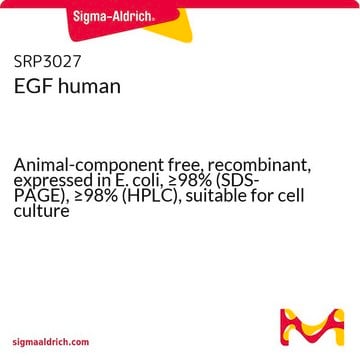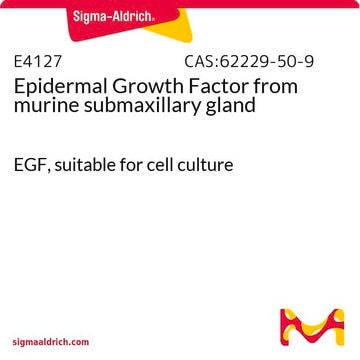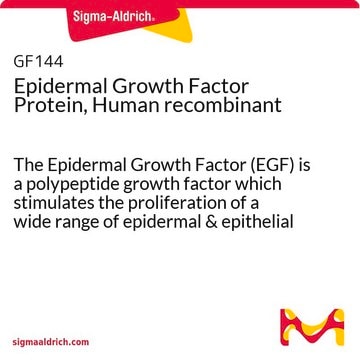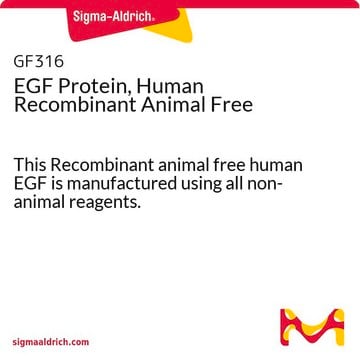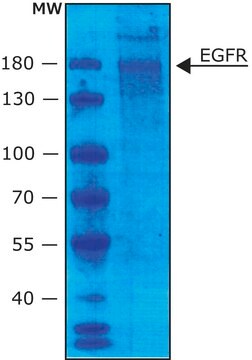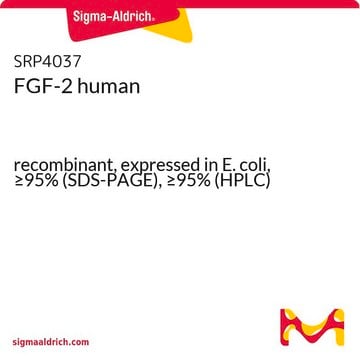E5036
Epidermal Growth Factor Protein, human
>97% (SDS-PAGE), recombinant, expressed in E. coli, lyophilized powder, suitable for cell culture
Sinónimos:
EGF
About This Item
Productos recomendados
Nombre del producto
Factores de crecimiento epidérmico human, EGF, recombinant, expressed in Escherichia coli, >97% (SDS-PAGE)
origen biológico
human
Nivel de calidad
recombinante
expressed in E. coli
Ensayo
>97% (SDS-PAGE)
Formulario
lyophilized powder
potencia
0.08-0.8 ng/mL EC50
mol peso
~6 kDa
envase
pkg of 200 and 500 μg
condiciones de almacenamiento
avoid repeated freeze/thaw cycles
impurezas
≤1 EU/μg Endotoxin
color
white
solubilidad
water: soluble 0.190-0.210, clear, colorless
Nº de acceso UniProt
temp. de almacenamiento
−20°C
cadena SMILES
S(CC[C@H](NC(=O)[C@@H](NC(=O)[C@@H](NC(=O)CNC(=O)[C@@H](NC(=O)[C@@H](NC(=O)[C@@H](NC(=O)[C@@H](NC(=O)[C@@H](NC(=O)CNC(=O)[C@@H](NC(=O)[C@@H](NC(=O)[C@@H](NC(=O)[C@@H](NC(=O)[C@H]%12N(CCC%12)C(=O)[C@@H](NC(=O)[C@@H](NC(=O)[C@@H](NC(=O)[C@@H](NC(=O)[C@@H](N
InChI
1S/C270H401N73O83S7/c1-24-134(19)217(262(420)293-112-201(355)298-161(69-74-205(359)360)229(387)301-160(45-35-82-286-269(279)280)228(386)333-192(119-428)255(413)307-162(68-73-198(274)352)230(388)316-176(94-141-54-64-150(350)65-55-141)241(399)304-159(44-34-
Clave InChI
GVUGOAYIVIDWIO-UFWWTJHBSA-N
Información sobre el gen
human ... EGF(1950)
¿Está buscando productos similares? Visita Guía de comparación de productos
Descripción general
Aplicación
- as a supplement in in LHC-8 medium to culture liver cell lines
- in the fetal bovine serum (FBS)-Dulbecco′s modified essential medium (DMEM) /F12 medium for primary culture of human glioma cells
- as an additive in the conditional medium of normal fibroblasts (NFs) to study its effect on the migration and invasion of endometrial cancer (EC) cells
- as a component in tumorsphere medium
Acciones bioquímicas o fisiológicas
Cita
2. Gregory, H., Isolation and structure of urogastrone and its relationship to epidermal growth factor. Nature, 257, 325-327 (1975).
3. George-Nascimento, C. et al., Characterization of recombinant human epidermal growth factor produced in yeast. Biochemistry, 27, 797-802 (1988).
4. Todaro, G.J. et al., Transforming growth factors produced by certain human tumor cells: polypeptides that interact with epidermal growth factor receptors. Proc. Natl. Acad. Sci. USA, 77, 5258-5262 (1980).
5. Blomquist, M.C. et al., Vaccinia virus 19-kilodalton protein: relationship to several mammalian proteins, including two growth factors. Proc. Natl. Acad. Sci. USA, 81, 7363-7367 (1984).
6. Eppstein, D.A. et al., Epidermal growth factor receptor occupancy inhibits vaccinia virus infection. Nature, 318, 663-665 (1985).
Código de clase de almacenamiento
13 - Non Combustible Solids
Clase de riesgo para el agua (WGK)
WGK 2
Punto de inflamabilidad (°F)
Not applicable
Punto de inflamabilidad (°C)
Not applicable
Elija entre una de las versiones más recientes:
Certificados de análisis (COA)
¿No ve la versión correcta?
Si necesita una versión concreta, puede buscar un certificado específico por el número de lote.
¿Ya tiene este producto?
Encuentre la documentación para los productos que ha comprado recientemente en la Biblioteca de documentos.
Los clientes también vieron
Artículos
Discover answers to your frequently asked questions about animal component-free, xenobiotic-free, and chemically defined media and reagents for cell culture.
Role of growth factors in stem cell differentiation and various growth factors for your research at sigmaaldrich.com
Nuestro equipo de científicos tiene experiencia en todas las áreas de investigación: Ciencias de la vida, Ciencia de los materiales, Síntesis química, Cromatografía, Analítica y muchas otras.
Póngase en contacto con el Servicio técnico
